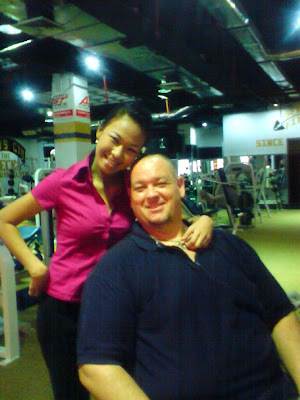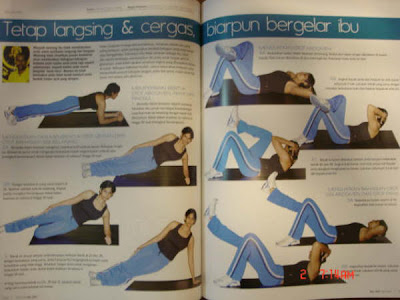Target Training – Learn how to handle body parts that are stubborn to change, or out of sight and out of mind. Such areas include the midsection (abdominal, oblique, lower back), lower leg (calf, shin) and lower arm (forearm).
Reducing Fat & Building Muscle Around The Midsection
When “love handles” is used to describe the halo of fat around a person’s midsection, it should be a call to action. But before trying to overcome the challenges of lowering one’s body fat percentage (to a healthy 15% or less for men, and 23% or less for women), you should know that there is no such thing as spot reduction. The body genetically dictates where fat accumulates and dissipates from. So people should focus on what they can control:
(1) nutrition – smart food choices based on recommended daily allowances, or the advice of a dietician
(2) cardiovascular exercise – to burn calories, shrink fat cells, and change body composition
(3) resistance training – to strengthen and develop muscles lying underneath the fatty areas.
Nutrition is the most vital of the three aspects in acquiring washboard abs. Muscles become visible, when the target area is exercised and fat surrounding the muscles is reduced. A poor diet will not provide adequate amounts of essential nutrients for energy to workout and allow the body to optimally function. Not even the best exercise routine can overcome this shortcoming.
In terms of fat/weight loss, the aim of cardiovascular training is to effectively burn significant amounts of calories. It is not how much fat a person burns that ultimately lowers body fat percentage, but how many calories are burned. This preferably requires large muscle movements of both the upper and lower body for extended periods of time (15 – 20 minutes for a stronger heart, and 20 – 60 plus minutes for muscular endurance and weight control).
Strengthening The Midsection: Perform each exercise for 1 – 3 sets/8 – 12 repetitions with 30 – 60 seconds of rest between each set. The tempo of the movement should be 3 counts on the eccentric phase (lowering), 2 counts on concentric phase (push or pull) and 1 count the stabilization/isometric phase (pause) To progress the intensity of the workout perform each exercise back to back, then rest 30 – 60 seconds and repeat 1 – 2 x.
1. Dumbbell Stability Ball Crunch (Upper Abdominal) – (a) Lie supine (face-up) on a stability ball (ball under lower back) with knees bent at a 90º angle and feet flat on the floor and shoulder width apart.
(b) Hold a dumbbell (5 lb – 20 lb) by the ends with the elbows bent and tucked close to the body.
(c) Slowly crunch the upper body forward and tuck the chin to the chest
(d) Return to starting position and repeat
2. Hanging Reverse Crunch (lower Abdominal) – (a) Grab an overhead straight-line bar with hands placed shoulder width apart (high enough that the feet do not touch the floor).
(b) Lift the knees and draw the hips towards the chest at the same time.
(c) Return the body to the vertical position and repeat.
3. Dumbbell Windmill (Oblique) – (a) Hold a dumbbell overhead (20 lb – 50 lb).
(b) Turn the feet out at a 45º angle away from the arm holding the dumbbell.
(c) While maintaining the dumbbell overhead, slowly lower the body so that the non-working hand touches the floor or front toe.
(d) Raise the body and repeat. Perform the exercise on the opposite side, then rest.
4. Reverse Hyper Back Extension (Lower Back) – (a) Lie prone (face-down) on a bench with the upper body supported by the bench and the lower body suspended in the air with the knees bent.
(b) Extend the legs behind the body, until the entire body is completely horizontal to the floor.
(c) Return to starting position and repeat.
Calf (Grastrocnemius & Soleus)

The gastrocnemius and soleus are muscles that cause plantarflexion, or heel elevation. But because they do so much work on a regular basis (i.e. walking & running), it is difficult to overload them with enough resistance to elicit growth; but not impossible.
Thoroughly training the calf requires a two-part approach: (1) straight leg plantarflexion exercise to work the gastrocnemius, the visible portion of the calf (2) bent knee plantarflexion exercise to develop the unseen soleus that is most active when the knee is at a 90º angle or less. One also needs to know that the gastrocnemius is primarily made up of fast-twitch muscle fibers that respond well to heavy loads and low repetitions. Conversely, the soleus is primarily composed of slow-twitch muscle fibers that thrive on moderate loads and high repetitions. Armed with this knowledge perform the following routine to add strength and size to the calves.
1. Single Leg Dumbbell Calf Raise For The Gastrocnemius (3 – 5 sets/8 – 12 repetitions, tempo 3/2/2, rest 60 – 90 seconds) – (a) Stand with one leg at the edge of a step or bench on the ball of the foot. Hold a dumbbell (10 lb – 20 lb) in the hand that is on the same side as the working calf. Use the free hand to hold on to a securely fixed object for balance.
(b) Raise the heel as high as possible, and squeeze the calf for two counts at the top of the motion.
(c) Slowly release and allow the heel to sink until the calf is fully stretched, then repeat.
(d) Perform the exercise on both legs, then rest.
2. Single Leg Squat Jump For The Gastrocnemius (3 sets/5 – 10 repetitions, tempo 2/x/x explosive, rest 60 – 90 seconds) – (a) Stand with feet shoulder width apart, and the arms outstretched and parallel to the floor (lift the chest, slightly retract the shoulders, and keep the chin down and the neck neutral).
(b) Lift one leg directly beside the base leg. Now flex the hip at a 90º angle and slightly flex the knee.
(c) Squat to the lowest point of compensation, then immediately bound into the air while simultaneously pulling both arms down quickly.
(d) Land softly by bending at the knee and hips on impact, and quickly return the arms to their starting position. Complete the exercise on both sides, then rest.
3. Barbell Seated Calf Raise For The Soleus (3 – 5 descending sets/8 repetitions w/heavy load, 12 repetitions w/moderate load, 25 repetitions w/light load = 45 repetitions per set, Tempo 2/1/1 or 1/1/1, rest 45 – 60 seconds) – (a) Place two 25 lb plates on the floor 4 – 6 inches apart in front of a flat bench. Sit on the bench and place the ball of one foot on the edge of each plate.
(b) Lay a barbell across the lower thighs about three inches above the knees. Then bring the hips forward until there is an 80º angle at the knee joint.
(c) Push through the balls of the feet and elevate the heels as high as possible.
(d) Lower the heels until the calves are fully stretched, then repeat.
Note: Begin each set with a heavy load for 8 repetitions, then decrease the load and continue for 12 repetitions, and decrease the load again and continue for 25 repetitions; all totalling 45 consecutive repetitions per set.
4. Dumbbell Sumo Squat Calf Raise For The Soleus (3 timed sets/30 – 60 seconds each, tempo 2/1/1 or 1/1/1, rest 60 – 90 seconds) – (a) Place your feet slightly wider than shoulder width apart, and point the toes away from the body’s midline at a 45º angle.
(b) Descend into a squat so that the thighs are parallel to the floor, and place a dumbbell (end over end) 3 inches above the knee on the lower thigh of each leg (maintain griping the dumbbells while holding them in position).
(c) Remain squatted while coming up on the balls of the feet to elevate the heel, then recover and repeat for as many times possible in 30 – 60 seconds before resting.
Shin (Anterior Tibialis)

Largely an ignored muscle, the anterior tibialis located on the front of the lower leg is primarily responsible for dorsiflexion (elevating the ball of the foot). Avid walkers and runners suffering from chronic shin splints will improve the condition by stretching and strengthening this area.
There are specific devices for exercising the lower leg, but it is rare to find them in most gyms. So readily available dumbbells and cables are next best for conditioning the shins.
1. Dumbbell Shin Curls (3 sets/12 – 25 reps, tempo 2/2/2 or 2/2/1, rest 30 – 60 seconds) – (a) Sit on a flat bench lengthwise with both legs supported except the 4- 6 inches above the ankle.
(b) Position a dumbbell between the feet, so that one far end rests on the top of the feet while the insteps grip the dumbbell’s handle.
(c) Flex the ankles to move the dumbbell towards the shins.
(d) Control the release and repeat.
2. Cable Shin Curls (3 sets/12 – 25 reps, tempo 2/2/2 or 2/2/1, rest 30 – 60 seconds) – (a) Place a flat bench in front of a cable cross pulley adjusted to the height of the bench, then attach a single handle strap to the pulley.
(b) Sit on the bench and place one foot through the handle strap (the handle grip is at the top of the foot).
(c) Slide the hips back and extend the working leg across the bench, except the 4 – 6 inches above the ankle. The opposite leg is bent at a 90º angle with the foot on the floor.
(d) Flex the top of the foot towards the shin, then release and repeat. Complete the exercise on the other leg before resting.
3. Dumbbell Heel Walking (3 intervals of 25 yards, rest 30 – 60 seconds) – (a) While holding dumbbells in each hand, walk slowly (with a six inch stride) on the heels of the feet with toes as high as possible in the air.
(b) Proceed for 25 yards.
(c) Point the toes of each foot in the air to stretch between intervals.
Forearm (Flexors & Extensors Of The Digits, Flexor Of The Elbow, Pronators and Supinators Of The Hand)

The forearm is comprised of numerous muscles that flex and extend the fingers and thumb, rotate the hand face-up or facedown, assist with flexion at the elbow, and allow the hand to grasp. The practical importance of strengthening the forearm is realized, when one is struggling to tightly hold heavy loaded handles, ropes and bars, especially during pulling movements.
The following exercise circuit will increase the size and strength of the forearms, better the grip and allow one to easily open those pesky lids on pickle jars. Perform 7 repetitions (tempo 2/2/1/) of each exercise in consecutive order with dumbbells (10 lb – 20 lb) before resting 30 – 60 seconds between 3 rotations.
1. Dumbbell Wrist Curl – (a) Take dumbbells in hand and kneel beside a flat bench (broadside), then place both forearms across the surface, except for 4 –6 inches above the wrists.
(b) Flex the wrists towards the biceps with palms facing up and squeeze the forearm muscles. Then slowly extend both wrists back to the starting position.
(c) Repeat for 7 repetitions and transition to the next exercise.
2. Dumbbell Hammer-Grip Wrist Curl – (a) The forearms remain on the bench, but face both palms inward with thumbs topside.
(b) Flex and extend the wrists like the exercise before, but with the hands in the new position for 7 repetitions.
(c) Continue to the next exercise.
3. Dumbbell Reverse-Grip Wrist Curl – (a) While the forearms are on the bench, rotate the hands so that the palms are facedown.
(b) Flex and extend the wrists with the hands in the new position for 7 repetitions.
(c) Proceed to the next exercise.
4. Dumbbell Wrist Curl w/Release Grip – (a) This movement is similar to the first exercise (dumbbell wrist curl) with the following exception. After flexing the wrists, slowly loosen the grip of the dumbbell as both wrists extend.
(b) The dumbbells’ handles will roll across the hands to the top of the palms and the mid portion of the fingers (the fingers should be partially flexed to keep the dumbbells from rolling completely out of the hands).
(c) After pausing the roll of the dumbbells with the fingers, retighten the hands’ grip around the handles and repeat the exercise for 7 repetitions. Then continue to the next movement.
5. Dumbbell Forearm/Wrist Roll – (a) Begin with forearms on the bench and palms facedown. Without the forearms losing contact with the bench, roll the wrists and forearms counter-clockwise to face palms upward.
(b) Then rotate clockwise to return to the starting position for 7 repetitions.
(c) Prepare for the next exercise by standing.
6. Dumbbell Hammer-Grip Bicep Curl – (a) Stand with feet shoulder width apart, and tuck both elbows tightly to the front of the body. Have the palms facing inward with thumb side tilted toward the midline at a 45º angle.
(b) Extend the arms slowly, then flex the biceps to return to the starting position for 7 repetitions.
(c) Upon completion of this exercise rest for 30 – 60 seconds, then repeat the series 2 more times.
ConclusionFrankly, any body part that lags in development because of genetic character or neglect is a hard gainer. Here are ways to get the most out of what you have, regardless of the muscle type, structure or location.
▼Side bar:5 Tips: To get hard gainers to respond to your will
 1. Prioritize –
1. Prioritize – Train areas of concern or that are not favorites at the beginning of an exercise routine, when you usually have the highest level of concentration and energy. Human nature dictates that one will procrastinate doing or avoid what is difficult or of least interest.
2. Train To Failure – Complete each set of an exercise so well that not another repetition can be achieved without resting. Once you are able to complete a specific number of repetitions and sets, increase the difficulty of performing an exercise (i.e. add load, decrease rest time, increase repetitions, destabilize the exercise).
3. Attitude – Take a “can do” attitude towards difficult training tasks. Break down ominous long-term goals into manageable short-term objectives in route to success.
4. Seek Professional Help – Hire a qualified personal trainer/coach to develop a goal-oriented plan, set measurable benchmarks, instil accountability, and help motivate achievement.
5. Nutrition – Eating well is one of the keys to changing body composition, whether the goal is to reduce body fat percentage or gain muscle mass.


















































